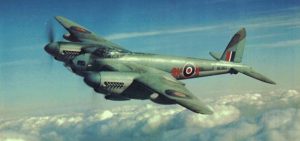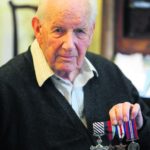
At 21:20 hrs on the evening of 26th July 1944, 178 Lancaster Bombers left various airfields in the east of England, their mission was to destroy the marshalling yard at Givors[vi]. They were accompanied by 9 Mosquitos from 627 Squadron who left RAF Woodhall Spa, taking off between 23:08 and 23:18 en route to Givors, just south of Lyon. Their mission was to deploy markers across the marshalling yard at Givors to assist in the accurate placement of the payload from the heavy bombers. Givors had been the target of numerous bombing raids during World War II, targeted by the Luftwaffe (or maybe the Italians – there is some suspicion that this is the case) in June 1940 and then a further 5 times during 1944 by both the RAF and USAF. Marshalling yards across France became the focus of intense bombing raids post D-Day in an effort to thwart the movement of reserves and military cargo across Europe by the German Army.
However, overnight 26th – 27th July 1944 the only thwarting being done was by the weather. Such were the weather conditions – hard to believe in late July – that those RAF crews who have committed their thoughts to paper in the intervening years chose to comment on this, of all storms, and the fact that, due to the weather they saw few German aircraft over mainland Europe.
One Lancaster crew member, Warrant Officer Clayton Moore, described the situation;
“ We lifted off just after 9pm, on what was to prove one of the most tiring and exacting eight hour flights we’d ever undertaken. The Met Office had got it wrong this time and we found ourselves flying in thick cloud for most of the outward flight. Then just as we neared about half an hour from the target, we started to ice up badly, so Bill (newly promoted F/L Bill Siddle) decided with reluctance that we should abort the mission and head back to base ”
The appalling weather impacted the whole operation. Noble Frankland recalled;

“This time the target was the railway installations at Givors near Lyon. As the time for take off approached a violent thunderstorm broke out. We sat in our aircraft watching the control tower fully expecting to see a red Verey fired which would have told us that the operation had been cancelled. It was not and so we took off ”
9 Mosquitos took part in the operation, 6 reported the near catastrophic effects of the weather on the plane. For example, icing on the wings, lack of compass use because of the electrical storm and the engine cutting due to the temperature. Despite the horrendous conditions 2 mosquitos managed to drop their markers and the Lancasters followed up with concentrated bombing.
DZ534 crewed by Flying Officers Gribbin and Griffiths ran short of fuel because of the additional stress of the aircraft resulting from the inclement weather and to make matters worse became disoriented due to the storm. They jettisoned into the sea and were picked up by the Royal Navy 12 miles east of Cherbourg, suffering nothing more than a few cuts and bruises.
However, the crew of DZ636 were not so lucky, the 627 Squadron Operations Records Book states that N- DZ636 crewed by Flying Officers Flaherty and Christie Failed to return – nothing heard since take off presumed lost in English Channel.
Flying Officer Flaherty was the pilot of DZ636, born Dennis Kieran Flaherty in 1921, the son of John and Mary Delia Flaherty from Bradford, Yorkshire. He was just 23 when he died.
His Navigator was Flying Officer John Christie, born in 1912 to James and Agnes Christie of Brechin, Angus. John was 32.
Nothing heard of DZ636
It is incredible that nothing was heard from DZ636 throughout the operation and yet they were obviously part of the formation as they travelled south. However, the problems caused by the storm and low temperatures go some way to explain how DZ636 disappeared from everyone’s view.
The remaining Mosquitos stayed within the target area from 01:34hrs for about 30 minutes. Presumably, since there were no reported sightings of DZ636 over the target area – it’s objective was marker 3 – then it is not unreasonable to surmise that it crashed en route to the target area in fact it crashed about 45 km from the target. If, this is the case then it would still be expected to be fully laden, there is testimony that suggests the aircraft was pas armé – This fact is doubtful. The aircraft was armed with bombing flares, which are unlikely to have survived a crash in tact, perhaps the witness was expecting to see a more ‘classic payload’?
A couple of sources suggest that the incident took place over night 21 / 22 July 1944, however it was in fact more likely to have occurred overnight 26/27 July 1944. This would be in line with the documentation from the the documentation of the Commonwealth War Graves Commission, Graves Registration Report and RAF Service Records, all state that both pilot and navigator died on 27th July 1944. In addition the web site of the Comité des Fêtes de Létra describes the funeral taking place on 31st July 1944 – 4 days after the crash.
Enterrement des aviateurs anglais qui avaient été abattus par la chasse allemande au-dessus de la vallée quatre jours plus tôt.
Then we can see from the Squadron flight records that show the details of the operation to bomb Givors overnight 26th – 27th July 1944. Overnight the 21st / 22nd July the operations record of 627 Squadron clearly shows that they flew no operations vi. There was a large bombing offensive carried out by the RAF, just short of 1000 km to the northeast, over Berlin. The 627 Squadron’s Mosquitos were certainly not involved in this operation and neither were Flying Officers Flaherty or Christie.
The Histoire Vécue des Maquis de l’Azergues describes – « un orage très violent se déchaîna sue la Vallée » – a violent storm overnight 21st to 22nd July. This night was a moonless night and the region was experiencing a heat wave. However there is no testimony by flyers of a storm 21/22and yet interestingly however, as per the examples above, such a storm overnight 26/27 was readily described in numerous other sources. It is worth noting that 130km southeast on the Vercors Plateau where a well-documented thunderstorm moved across the plateau providing a welcome respite to the German onslaught of the Resistance at that location.
How many people died?
However, having located the wreckage, 2 bodies were recovered and taken to the mortuary at Letra. Witness testimony in both Histoire Vécue des Maquis de l’Azergues and Ce quue j’ai connu de la Resistance both make mention of three bodies being recovered from the Mosquito. I can find no evidence to substantiate this. As described above, it was possible to carry out a temporary adaptation to the bomb bay in a Mosquito to allow for the transportation of a third person. However, there is no evidence to suggest that this was the case. The flying records clearly show that the role of DZ636 on this night was to drop marker 3 and it would be fanciful to suggest that, for example, that DZ636 was carrying out some secret mission that even necessitated the forging of the official squadron records and that such an operation would remain secret to this day. Plus and perhaps more obviously, there are only 2 graves in the cemetery at Letra, those of the two Flying Officers. Where is the third body? Is there a third body? The final piece of the jigsaw for me rests with establishing the method of identification of the two flying officers.
Flying Officer Flaherty and Flying Officer Christie were buried with full military honours on 31st July 1944 in the village of Letra[xvii]. There are reports of the Luftwaffe observing the funeral from the sky; this would undoubtedly have been part of the Anti-Partisan Operations Unit that operated out of Bron. To help corroborate the date the flying records show some activity in the valley d’Azurgues on the 31st – On or around the earlier date and the entire Luftwaffe Anti-Partisan Operations unit were fully committed on operations against the Vercors Plateau
Why did the aircraft crash?
As to why DZ636 crashed, one can only surmise. There was, without doubt a ferocious storm across large swaths of Europe that night, bringing the heat wave to a close. The other Mosquitos of the squadron had experienced problems of wings icing, engines icing and other catastrophic failure as a result of the storm including disorientation through the instrument failure. There is no suggestion that DZ636 was shot down, it was more likely as a result of icing, inability to navigate or even a direct lightening hit.
Whatever happened it is true that these two flying officers lost all contact very early in the mission. Notwithstanding this, they continued with their mission despite being, what one survivor described as, one of the most tiring and exacting eight hour flights ever. Without doubt Flying Officers Flaherty and Christie died heros, alone on a desolate hillside and in death they were treated with respect and dignity.
